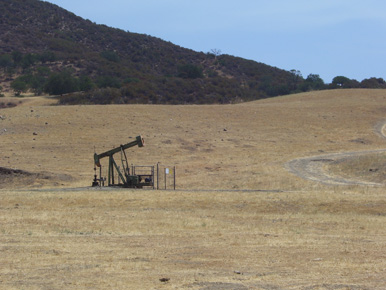
A top official with the California Department of Conservation addressed the county board Tuesday about enhanced oil recovery practices – in light of Measure J on the coming ballot – while noting about half of state oil production is from extraction methods targeted in the proposed ban but that smaller petroleum companies are slow in reporting required well data.
Jason Marshall, chief deputy director of the state conservation department, spoke to supervisors Tuesday upon request from Supervisor Margie Barrios. She publicly opposes the measure on the November ballot – aiming to ban fracking, cyclic steaming and acidizing countywide and all petroleum activities in rural residential zones near the two cities – and asked for a presentation to the board and public.
Marshall pointed out that his agency oversees regulation of oil and gas operations in the state and does not advocate for the industry. He talked about the state’s unique geology and how it affects industry practices; San Benito County’s current level of production; current restrictions from the state on such matters as water monitoring and disclosure of chemical use; coming, similar restrictions as part of an approved senate bill; the history of fracking in the state; and the potential of the Monterey Shale.
Marshall said as things stand, 51 percent of all oil production in the state is through “tertiary” mechanisms, or enhanced recovery methods targeted in the proposed ban as opposed to conventional forms of extraction. Those enhanced methods are needed due to the state’s faults and a need to fracture the shale vertically and not horizontally like in other places.
“You’re modifying the oil formation to increase the flow in the well,” Marshall said regarding tertiary methods, as he showed graphics in a PowerPoint presentation. “Steam – consider that tertiary. Steaming the oil thins it. It makes it more possible to flow.”
Steaming is among the three extraction practices facing a possible ban in San Benito County due to Measure J, proposed by a group calling itself Protect San Benito. Its members claim that fracking and other enhanced practices pose risks for contamination and use too much water, while measure opponents point out there is no fracking planned here, enhanced practices use relatively minimal water, and cyclic steaming and acidizing wells are merely common industry practices. Many of the Measure J supporters and opponents showed up to the board meeting and spoke as well.
So did supervisors, who questioned Marshall after his presentation. Supervisor Robert Rivas, a Measure J supporter, expressed concern about lacking data available pertaining to disclosures from oil companies on the website for the Division of Oil, Gas & Geothermal Resources, part of the department of conservation. That agency, known as DOGGR, is in the process of implementing new standards from Senate Bill 4, approved in 2013 with a slew of regulations for enhanced recovery practices such as fracking. Some of the new rules were implemented in January as interim stipulations, such as water monitoring and disclosure requirements, while others are coming next July.
Marshall said larger oil companies have a grasp of the new requirements, while smaller ones are having more difficulty with the reporting requirements.
“Part of their challenge has been, frankly, getting the information from their service provider,” Marshall said of contractors – such as Halliburton or Baker Hughes – working for those oil companies on fracking jobs.
Marshall referred to such a matter as a “paper violation” and said companies could be fined as much as $10,00 per violation daily.
“My patience with them in getting it right is waning,” he said.
But the deputy director also said those delays don’t change the environmental protections in place through SB-4.
“They still had pressure testing. They’re doing neighbor notification,” he said. “The problem, we haven’t yet gotten information about jobs posted on the website. We’re still arm wrestling with the operator to get information.”
Marshall in his presentation that 51 percent of all oil production in California is done through enhanced practices that have been used since the 1960s.
He talked about the use of chemicals in the fracking process, which involves fracturing the shale to create fissures – which stay open with the use of sand – through which oil or natural gas can flow. He said a chemical called guar gum is used to make the water more gelatinous, and another called biocides is used to ensure bacteria aren’t introduced into the formation.
As for state geology, he said it doesn’t lend itself well to fracking. Instead, many oil developers here use vertical fracturing – which requires about 85 percent less water use as opposed to horizontal elsewhere.
Marshall called one part of SB-4 – required baseline water monitoring – a “landmark change.”
“It’s not just increased prevention, but also monitoring after the fact,” he said.









